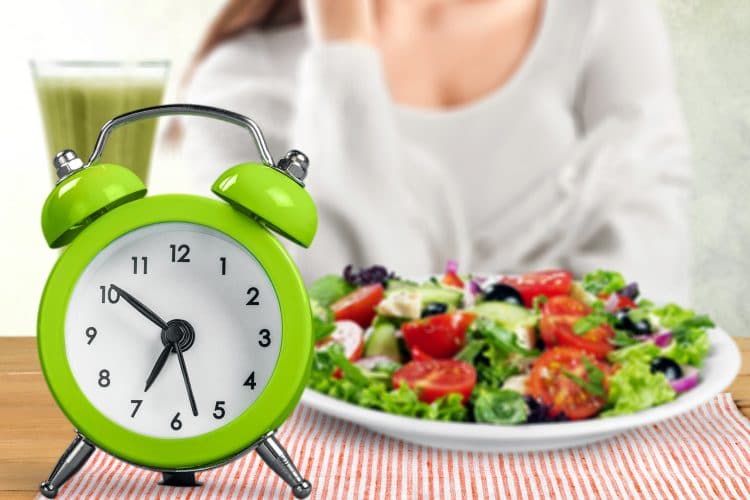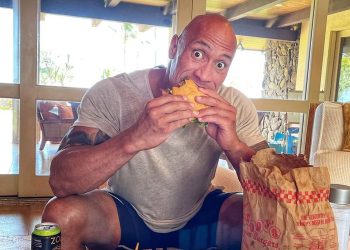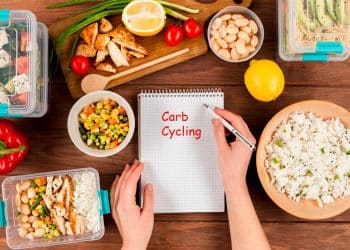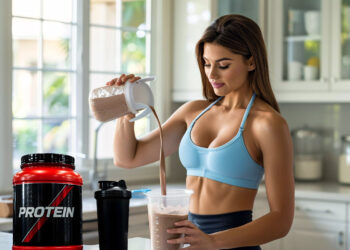There is a massive difference between being lean and being ripped. When you are lean, you usually have a flat stomach, a little muscle definition, and not much jiggles when you run.
However, when you are ripped, you look like a walking, talking anatomy chart, with every muscle standing out clearly. You’ll be able to see bands of muscle fibers, called striations, and you’ll see those fibers move every time you contract your muscles.
To be considered lean, your body fat needs to be around 12-15% for men and 18-20% for women. But, to be ripped, your body fat needs to be 10% or less. Frustratingly, that last few percent is often the hardest to lose.
While not everyone is blessed with the genetics to get ripped, you won’t know until you try. And by try, we mean dedicating the next few months to shedding fat. In this guide, we reveal the strategies you’ll need to use to get your body fat percentage down to 10%.
Nutrition to Reach 10% Body Fat
The first and arguably the most important factor to consider on your journey to reach 10% body fat is your diet. After all, you are what you eat, right?
To lose fat, you need to eat less and create a calorie deficit. Faced with this shortfall in energy, your body has no choice but to start burning fat for fuel. Maintain your calorie deficit for long enough, and you should reach 10% body fat.
Level Up Your Fitness: Join our 💪 strong community in Fitness Volt Newsletter. Get daily inspiration, expert-backed workouts, nutrition tips, the latest in strength sports, and the support you need to reach your goals. Subscribe for free!
However, while that sounds simple on paper, the reality of dieting is very different. There is a reason that so many people who try to lose weight fail; dieting is HARD!
So, to help you, consider the following tips to make achieving your 10% body fat goal easier.
Determine Your TDEE
TDEE stands for total daily energy expenditure and is the number of calories you burn per day. To burn fat, your calorie intake must be less than your TDEE. Generally, a deficit of 300-500 calories per day should result in sustainable fat loss.
There are equations you can use to determine your TDEE but to save you from all the math that entails, use our online TDEE calculator instead. While not 100% accurate, this will give you a good idea of how much you can eat while still losing fat.
Remember, as you lose weight, your TDEE will drop, so make sure you adjust your food intake to reflect your progress.
Start Counting Calories
If there is one thing that dieters are generally very bad at, it’s estimating how much food they’ve eaten. Usually, they underestimate their calorie intake, and that will quickly put the brakes on fat loss.
Counting calories is a chore, but it’s easier than it used to be. Back in the old days, after weighing your food, you had to look the calorie value up in a book, write it down, and add up your totals for the day. Nowadays, you can use an online database or an app to do most of the work for you.

If you don’t measure your calorie intake, you won’t be able to manipulate it, so start tracking your calories as soon as you can.
Adjust Your Macros
The calories you eat come from protein, carbohydrates, and fat, which are collectively called the macronutrients, or macros for short. The ratio between the macros can affect your rate of fat loss, muscle retention, and energy.
There are several different accepted macro ratios you can use to get ripped, so it may take a little experimentation to find out what works best for you. For example, some people thrive on very low fat/moderate carbs/high protein diets. In contrast, others do better with low carb/moderate protein/high fat. You may even prefer an isocaloric approach, where you consume equal amounts of the three food groups.
Whichever you choose, you can use our macronutrient calculator to make your intakes easier to manage.
However, whatever macro ratio you choose, make sure you consume adequate protein.
Protein is crucial for trying to reach 10% body fat because:
- It helps prevent muscle catabolism during your diet (1)
- It’s satiating so you feel fuller for longer
- It’s thermogenic and increases your metabolism more than the other macros
You should aim to consume around one gram per pound of body weight, which may increase to 1.5 grams per pound as you close in on your goal. Use this protein calculator to determine your ideal protein intake.
Diet Don’t Starve
For most people, getting down to 10% body fat is a long-term goal. That means it’s going to take months rather than days or weeks. Dieting too strictly usually causes terrible hunger and cravings. Hunger and cravings mean you are much more likely to give up before reaching your goal.
Increase your chances of success by avoiding extreme diets or cutting your calories too aggressively. Slow, steady, sustained progress is better than rapid weight loss followed by giving up.
So, while you WILL need to change your diet, eat less, and maybe even work out harder and longer, you need to make sure that, whatever you do, it’s sustainable. Not for a week or two, but for as long as it takes to get down to 10% body fat.
Try Carb Cycling
With carb cycling, your food intake changes to reflect your activity levels. Contrary to bro-science, this won’t “confuse your metabolism.” Instead, it just balances your intake of energy with your expenditure.
In simple terms, you eat a little more carbs on training days and slightly less on the days you are not as active. While carb cycling won’t magically lead to rapid fat loss, it may enhance your progress and get you to your 10% body fat goal just a little quicker and more easily.
Read more about carb cycling here
Try Intermittent Fasting

Intermittent Fasting known as IF for short, this strategy can help you drop body fat a little faster. In straightforward terms, IF means skipping meals to create a larger calorie deficit while also increasing human growth hormone production and insulin sensitivity.
Because IF can result in muscle loss, it’s essential not to use it for too long or too often. But, if you need to shed that last couple of pounds of fat, IF can help. You can read more about intermittent fasting here.
Read also:
- 16:8 Intermittent Fasting Guide and Tips
- 20:4 Intermittent Fasting Guide and Tips
- Periodic Fasting (24-Hour Fasting Once A Week)
Supplements to Reach 10% Body Fat

While there are no safe or legal supplements that will magically melt fat from your body, there are a few things you can use that may help make getting to 10% body fat a little easier.
However, even the best supplements won’t do much for you if you aren’t eating right, training hard, and have a healthy general lifestyle.
Useful supplements include:
Training to Reach 10% Body Fat
Training to reach 10% body fat should achieve two things – increase your calorie expenditure to speed up fat loss and preserve your existing muscle mass. Both are equally important and usually mean combining strength training with cardio.
Bear in mind that it’s almost impossible to out-train a bad diet, so if you aren’t killing it in the kitchen, no amount of training will help you reach 10% body fat. So, make sure your diet is nailed down before diving headlong into your workouts.
Follow these guidelines to train yourself down to 10% body fat:
Prioritize Strength Training
Don’t be tempted to overdo the cardio in an effort to shed fat. Yes, cardio does burn fat for fuel, but it can also lead to muscle breakdown. Losing muscle will decrease your metabolic rate, and that means your fat loss progress will be slower.

Plus, you want a decent amount of muscle mass to show off once you are super-lean. Otherwise, you’ll just be another skinny dude. Lean AND muscular is a much better look!
Level Up Your Fitness: Join our 💪 strong community in Fitness Volt Newsletter. Get daily inspiration, expert-backed workouts, nutrition tips, the latest in strength sports, and the support you need to reach your goals. Subscribe for free!
Prioritize strength training and do your best to keep lifting heavy weights to preserve your existing muscle mass. You will probably lose some strength along the way, as some muscle loss is almost unavoidable. Still, you should do your best to minimize this by continuing to lift heavy.
Ideally, you should adopt a training program that involves training each muscle group twice per week. Examples include:
Optimize Your Strength Workouts for Fat Loss
Strength training often gets a bad rap for fat loss because you spend so much time resting between sets. You might be in the gym for 90 minutes, but over half that time will be spent sat waiting to start your next set.
There are several ways that you can make your strength workouts better for fat loss, including:
- Make your rest period more active, e.g., by jumping rope between sets
- Doing supersets
- Circuit training
- Complexes
- EMOM training
- Adding a finisher to your workouts
Use But Don’t Abuse Cardio
Cardio burns calories and fat, but do too much, and you run the risk of undermining your strength workouts and losing muscle. Both slow and steady LISS cardio and faster-paced HIIT can help you get leaner, but if you feel like you need to do hours of cardio every day, you are probably eating too much.
Read also: HIIT vs. LISS Cardio: Which One Is Best for Fitness and Fat Loss?
Initially, limit yourself to 20-30 minutes of cardio 3-4 times a week and see how you progress. Increase cardio a little if necessary but remember that doing more could be detrimental to your progress. After all, you want to look like a powerful sprinter and not an underfed marathon runner, right?
Do More NEPA
NEPA stands for non-exercise physical activity. It’s also known as NEAT or non-exercise activity thermogenesis. Whatever you call it, this type of activity can have a significant impact on your rate of fat loss.

Most people are sedentary. This is the result of things like technological advancements, automated transport, passive entertainment, and labor-saving devices. Even if you are an ardent exerciser, out of the 168 hours in a week, you are probably only active for 5-10% of the time. Otherwise, you’re sat on your butt staring at a screen.
The more active you are, the higher your caloric expenditure will be. Still, if you exercise more, you will simply tire yourself out and run the risk of breaking muscle down faster.
NEPA is simply a physical activity that gets you up and moving, increasing your calorie expenditure in the process. It’s not tiring, and nor is it structured. It’s just anything that you can do that doesn’t involve sitting.
Examples include:
- Walking for pleasure or transport
- Washing your car by hand
- Gardening
- Putting out the trash
- Shoveling snow or raking leaves
- Mowing the lawn by hand
- Playing with your kids
- Playing recreational sports
- Cycling for transport
- Cleaning and chores around the house
The more NEPA you can accumulate during the day, the more calories you’ll burn, and the faster and more easily you’ll reach your 10% body fat goal. Set a “get up and move” alarm on your watch or phone to remind you to do something physical every hour or so, even if it’s just a quick walk around your office.
Do Mini-workouts
Short on time? Aren’t we all! Rather than miss a planned workout because you are too busy, find 5-10 minutes and do one of our mini-workouts. While a mini-workout can never replace a full gym session, it’s better than nothing and should help keep you on track toward your 10% body fat target.
Maybe you can do 2-3 over the course of a day to accumulate a decent amount of training time without hitting the gym. Either way, missing workouts will make reaching 10% body fat much harder. Use mini-workouts anytime that you are unable to stick to your training program.
Important Lifestyle Habits to Reach 10% Body Fat
What you do in the kitchen and the gym will have the most significant impact on your journey to reaching 10% body fat. However, even if you eat right and train hard, there may be things in your life that undermine your progress.
Consider the following to make sure that you aren’t inadvertently sabotaging your results:
Get Enough Sleep
Sleep is critical for both muscle preservation and fat loss. Most adults need 7-9 hours of sleep a night, and getting less could cause the following (2):
- Decreased testosterone, human growth hormone, and insulin-like growth factor
- Increased cortisol leading to muscle breakdown and fat storage
- Elevated insulin resistance
- More hunger and cravings
- Less willpower
- Lower energy and motivation for exercise
Read more about the effects of sleep on muscle gain and weight loss, plus strategies for getting more sleep.
Related: Can ZMA Help Build Muscle And Support Sleep?
Reduce Stress
Too much stress can have a profound and unhealthy effect on your body. Stress causes a rise in cortisol which is a hormone associated with muscle catabolism and fat storage.
Stress is often part and parcel of modern life. Sources of stress include work and money worries, relationships and family, perceived lack of time, poor self-confidence, and a genetic predisposition to stress.
Beating stress is not easy and may require significant lifestyle changes. For example, if you hate your job and work is a source of constant pressure, it may be time to consider a career change. Needless to say, that IS a big decision and may not be practical at the moment. Still, sometimes significant changes are what’s needed to reduce stress.
If you can, look for ways to reduce the stress in your life. For more information on stress and stress relief, check out this article.
Respect your body’s need for rest and recovery – training for fat loss while eating less means your workouts are going to take more out of your body than usual. To avoid hitting a training plateau, you MUST pay attention to your body’s need for rest and recovery. If you don’t, you may find yourself unable to continue on your path to reaching 10% body fat.
Sleep is a must, but there are other things you can do to enhance recovery, including:
- Contrast showers
- Massage
- Foam rolling
- Recovery workouts
- Compression clothing
Read more about how to maximize recovery here.
Go Easy on The Booze
Alcohol contains seven calories per gram. As such, you should include your alcohol intake when you are tracking your calories. However, alcohol is more than just a source of energy and can undermine your progress in other ways.
Drinking alcohol in excess can:
- Increase hunger
- Cause the accumulation of abdominal fat (aka the beer belly)
- Lower willpower
- Impair sleep
- Impede fat burning
- Cause dehydration
- Increase the risk of accidents
While you will probably be able to fit the occasional beer or glass of wine into your fat loss diet, drinking alcohol in large quantities will make reaching 10% body fat even harder than it already is. If you are an “all or nothing” drinker, it may be better to swear off the booze for the next few months.
Read also: How to Drink Alcohol Without Losing Muscle and Gaining Fat
10% Body Fat – Wrapping Up
Not everyone reading this will be able to reach 10% body fat. Some people are genetically programmed to hold more body fat than others. That’s good news if you are stranded on a desert island with no food, but not so good if you want to get ripped!
Others lack the psychological skills to get really lean. After all, hitting 10% body fat will require determination, motivation, and willpower, and not everyone has those things.
But then, if it was easy, everyone would be ripped, right?!
That all said, if you apply the information in this guide to your diet and workouts, you CAN get leaner. While you may never cross the 10% body fat threshold, even if you just shed your excess blubber and get leaner, you’ll look and feel better and can be justifiably proud of your achievement.
However, suppose you have the tools necessary to reach 10% body fat and stick with your plan. In that case, you’ll be rewarded with muscles that look like they’re covered in shrink-wrap, with every detail clearly visible.
Not many people manage to get truly ripped. Are YOU up to the challenge?
References:
- Leidy HJ, Clifton PM, Astrup A, Wycherley TP, Westerterp-Plantenga MS, Luscombe-Marsh ND, Woods SC, Mattes RD. The role of protein in weight loss and maintenance. Am J Clin Nutr. 2015 Jun;101(6):1320S-1329S. doi: 10.3945/ajcn.114.084038. Epub 2015 Apr 29. PMID: 25926512.
- Institute of Medicine (US) Committee on Sleep Medicine and Research; Colten HR, Altevogt BM, editors. Sleep Disorders and Sleep Deprivation: An Unmet Public Health Problem. Washington (DC): National Academies Press (US); 2006. 3, Extent and Health Consequences of Chronic Sleep Loss and Sleep Disorders.









